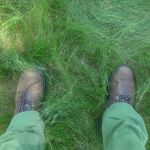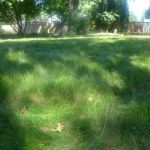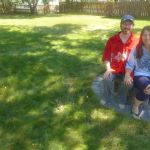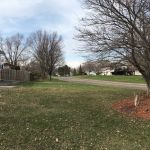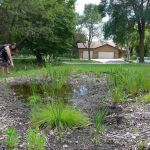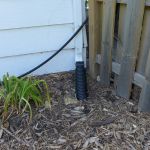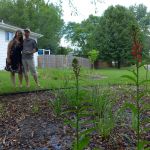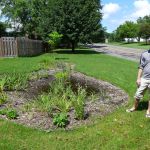Neighborhood Spotlight: Green Family
VADNAIS HEIGHTS – In a neighborhood that was historically wetland, drainage in yards and basements can be a challenge. The Green’s property is in such a neighbor hood and also has medium to heavy clay soil, which tends to retain water. It's understandable that this can be tricky and even at times frustrating. However with some careful planning and harnessing available resources, the Greens strived to find a fine balance between practicality, aesthetics, and support for downstream neighbors.
The Green's raingarden features two infiltration basins that receive water from both the roof and the basement sump pump. Downspouts from the roof direct runoff underground through a buried perforated pipe and into the sides of the raingarden basins, while the sump pump directs sump pump water into a dry creek (rock bed) and into the center of the garden. The garden is built far enough away from the foundation to prevent additional saturation close to the foundation. A soil amendment with sand and compost help to support drainage in the raingarden, while an overflow is designed to direct water into the grass towards the street when the raingarden is full.
Raingardens range from simple to complex depending upon homeowner preference. The Greens opted for a diverse selection of plants that flower at various times of the year to help support pollinators. Cardinal flower, Culver’s root, and blue flag iris are some of the plants that were selected, which are valuable for pollinators and do especially well with wet soils. The project cost was $4,400, VLAWMO provided $2,000 in grant funds.
Several years later when the Greens were again eligible for VLAWMO grant funding, they had their sights on a new lawn routine. In 2020 they applied for and received funding for a low-mow fescue lawn, and worked with a professional landscaper to have it installed. Most recently in 2023, the Greens completed a VLAWMO rainbarrel grant to help fund the addition of a new rainbarrel.
Turf Chat:
How do you take care of the lo-mow lawn and how is that different from the former conventional lawn? How is this working out from season to season?
Once it’s established, there’s a lot less work required for the lo-mow lawn than our old conventional lawn. We only need to mow twice a year – once in the spring to cut down the seed heads, and once in the fall to clean it up for the following spring. We don’t water it much if at all, but it remains green longer than the surrounding conventional lawns. It’s also very thick, so we don’t get a lot of weeds. Getting the lawn established has taken a fair amount of maintenance due to uncooperative dry weather in 2021-2022, but once it gets going, it is well worth it.
What's your favorite part about the lawn, and what are some things that you might need time to get used to?
Our favorite part about the lawn is not having to maintain it. We also love the swirly look, though that it something that some people may need time to get used to. If you like the golf course look, a no-mow lawn is not for you. There really hasn’t been anything that we dislike about it.
Any tips for others who may be interested in making the switch?
We used two different methods to seed the lawn, and hydroseeding was by far the more effective. We’d recommend hydroseeding in the fall. Be prepared to do a fair amount of maintenance the first year, including watering, weed management, and overseeing as necessary.
Raingarden Chat:
What do you enjoy most about the raingarden?
We enjoy how much interest it adds to our yard. When we moved in 2 years ago, the area that’s now the raingarden was a boring, flat piece of land. It looks so much nicer now! Before the project, there were also downspout extenders and a sump pump discharge sticking out into the middle of our yard. They were very long, unattractive, and even annoying to work around. We were able to bury the downspouts and send them and the sump pump discharge through a dry creek into the raingardens, which is a wonderful improvement.
How has it changed your interaction with your yard?
Since this is the first year since we installed the project, it’s been fun to see all of the new growth pop up. We’ve also been paying a lot more attention to our side yard, opposed to it being just vacant space. The project has also prompted me to appreciate and think more about native plants, with a possibility of adding a flower garden in the back yard.
What’s the most challenging part of the raingarden?
Identifying which plants are supposed to be there and which are weeds. We’ll surely get better at that over time, but for now, we're still very new to gardening in general, so it’s a bit of a challenge. The additional weeding does require us to spend more time doing yardwork for now, but the raingarden plants were selected and planted to fill in more over time, so time commitment should decrease. In the meantime, we’re trying to get the bad plants out so that the desired plants get well established.
What has surprised you as you’ve maintained the garden and watched it grow?
We have attracted hummingbirds, which is a great surprise! We love seeing the three B’s that come to visit – birds, butterflies, and bees.
What would you do differently if you created another garden?
We would have removed some of the clay that is in our yard and brought in some new compost soil for better infiltration. We had some challenges with plants drowning last fall when it wouldn’t stop raining. At the time, there was sitting water for close to a week after a storm, and since we got so much rain, the basin was almost perpetually full. This spring, we dug additional drainage holes to help it out, and now the water soaks into the ground after about two days.
Learn more about our cost-share program on our grants page.

